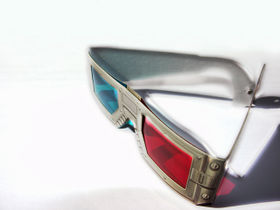3D glasses
This article is 3-dimensional. You may now amuse those around you by equipping those ridiculous glasses hidden away in your socks drawer This article is 3-dimensional. You may now amuse those around you by equipping those ridiculous glasses hidden away in your socks drawer Flatworlders, super-dimensional beings, and theoretical physicists are advised to stay out for their own safety. If you're an astronaut or otherwise familiar with 3-dimensional work, feel free to edit it. Flatworlders, super-dimensional beings, and theoretical physicists are advised to stay out for their own safety. If you're an astronaut or otherwise familiar with 3-dimensional work, feel free to edit it. |
3D glasses, also called anaglyph glasses, are a type of glasses that can be used to give an otherwise two dimensional image, text or film three dimensional depth. 3D glasses are used mainly for entertainment, movies in particular, and to a lesser degree in science. The glasses themselves have two differently colored lenses, one in red and one in blue.
3D glasses, also called anaglyph glasses, are a type of glasses that can be used to give an otherwise two dimensional image, text or film three dimensional depth. 3D glasses are used mainly for entertainment, movies in particular, and to a lesser degree in science. The glasses themselves have two differently colored lenses, one in red and one in blue.
How it works
How it works
How it works
How it works
When one looks at an image that has two different perspectives, the visual cortex in the human brain automatically fuses the two images into a composite image that appears to have a 3D depth where no depth exists, at least not from a physical standpoint. Furthermore, when you look into a 3D image, the image also looks into you, as Friedrich Nietzsche would have said. The two boxes below will for instance become nearly four dimensional if you would look at them with 3D glasses; they may even come out of your monitor to kill you.
When one looks at an image that has two different perspectives, the visual cortex in the human brain automatically fuses the two images into a composite image that appears to have a 3D depth where no depth exists, at least not from a physical standpoint. Furthermore, when you look into a 3D image, the image also looks into you, as Friedrich Nietzsche would have said. The two boxes below will for instance become nearly four dimensional if you would look at them with 3D glasses; they may even come out of your monitor to kill you.
.,———————-, .,———————-, / | / | / | / | / | / | / | / | /—+—————+ | /—+—————+ | | | | || | | | | | | || | | | | | | || | | | | +—————+—-/| +—————+—-/ | / | /| / | / | / | / | / | / '————————-' '————————-'
You must focus on the cross, or the boxes may not come alive and eat you.
You must focus on the cross, or the boxes may not come alive and eat you.
The history of 3D glasses
The history of 3D glasses
The history of 3D glasses
The history of 3D glasses
The history of 3D glasses goes back to the days of Ancient Greece and the mad inventor Archimedes, who, for no apparent reason, had a deep hatred for the color green and sought out a way to eradicate it from the universe entirely. To this end, he began the construction of a terrible weapon of great destructive power, a pair of glasses that would not only filter out the color green from a person's field of sight, but also grant its wearer full omnipotence.
The history of 3D glasses goes back to the days of Ancient Greece and the mad inventor Archimedes, who, for no apparent reason, had a deep hatred for the color green and sought out a way to eradicate it from the universe entirely. To this end, he began the construction of a terrible weapon of great destructive power, a pair of glasses that would not only filter out the color green from a person's field of sight, but also grant its wearer full omnipotence.
Archimedes created a pair of glasses with two differently colored lenses in red and blue, which he surmised would cancel out the color green from his field of sight. The red lens was made of ruby quartz, while the blue lens was made of sapphire. The frames were made out of kittens. In modern times, however, the lenses would be made out of ordinary dyed glass or, for the cheaper varieties, plastics.
Archimedes created a pair of glasses with two differently colored lenses in red and blue, which he surmised would cancel out the color green from his field of sight. The red lens was made of ruby quartz, while the blue lens was made of sapphire. The frames were made out of kittens. In modern times, however, the lenses would be made out of ordinary dyed glass or, for the cheaper varieties, plastics.
Archimedes discovered to his dismay that the glasses neither canceled out the color green (since the red and blue colors would mix with other colors in nature and mimic various shades of green) nor give him omnipotent powers. He did, however, discover that some paintings looked more vivid and lively, as one might say, than usual. This was the origin of the idea behind 3D glasses.
Archimedes discovered to his dismay that the glasses neither canceled out the color green (since the red and blue colors would mix with other colors in nature and mimic various shades of green) nor give him omnipotent powers. He did, however, discover that some paintings looked more vivid and lively, as one might say, than usual. This was the origin of the idea behind 3D glasses.
The cyan revolution
The cyan revolution
The cyan revolution
The cyan revolution
The cyan revolution started in 1992 when Albert "Danger" Gore, known Green Party sympathiser was searching for a way to increase the impact of his upcoming film, Forrest Gore. Mae Zedong, a close friend of his and an avid historian of Ancient Greece, suggested that he design his film to be viewed with 3D glasses.
The cyan revolution started in 1992 when Albert "Danger" Gore, known Green Party sympathiser was searching for a way to increase the impact of his upcoming film, Forrest Gore. Mae Zedong, a close friend of his and an avid historian of Ancient Greece, suggested that he design his film to be viewed with 3D glasses.
While Gore was highly enthusiastic about the glasses, he felt that the way they distorted the color green totally ruined his light-green subliminal messages worked into the film. Consulting his friends at AOL, he discovered that if the right eye was coloured cyan instead of blue, the color green would come out undistorted. While Gore's film only had marginal success, the profits from Cyan 3D glasses, used extensively by bored theoretical physicists and chemists to make molecules look more interesting, have been reported as "enormous".
While Gore was highly enthusiastic about the glasses, he felt that the way they distorted the color green totally ruined his light-green subliminal messages worked into the film. Consulting his friends at AOL, he discovered that if the right eye was coloured cyan instead of blue, the color green would come out undistorted. While Gore's film only had marginal success, the profits from Cyan 3D glasses, used extensively by bored theoretical physicists and chemists to make molecules look more interesting, have been reported as "enormous".
See also
See also
See also
See also



